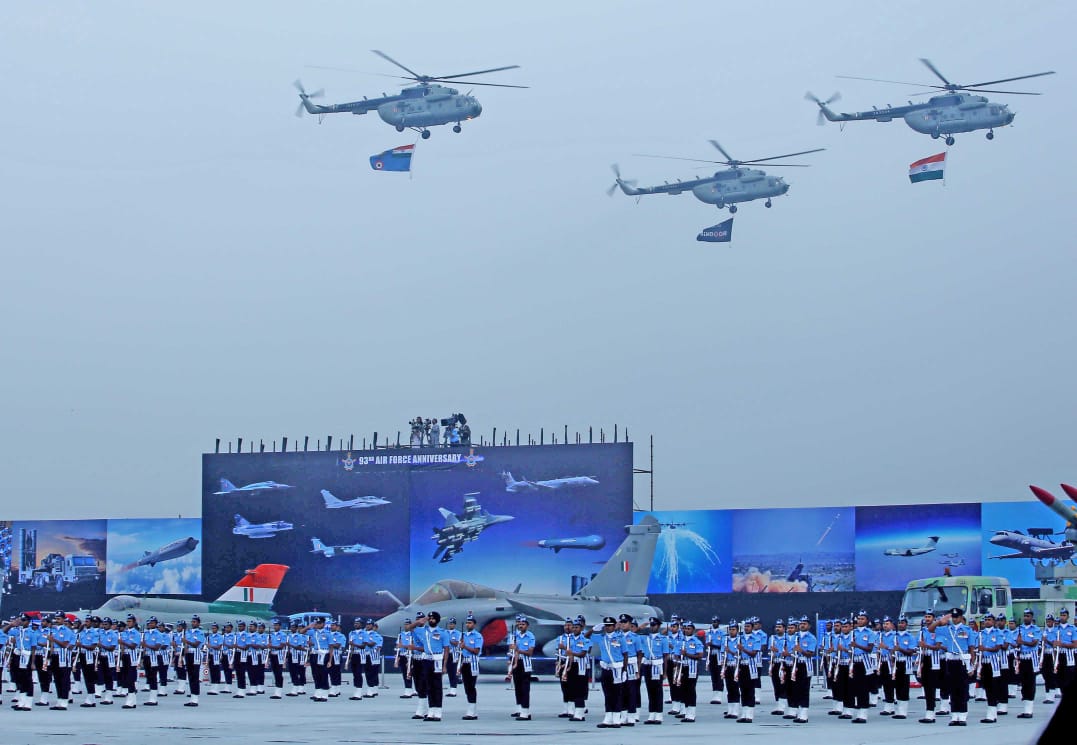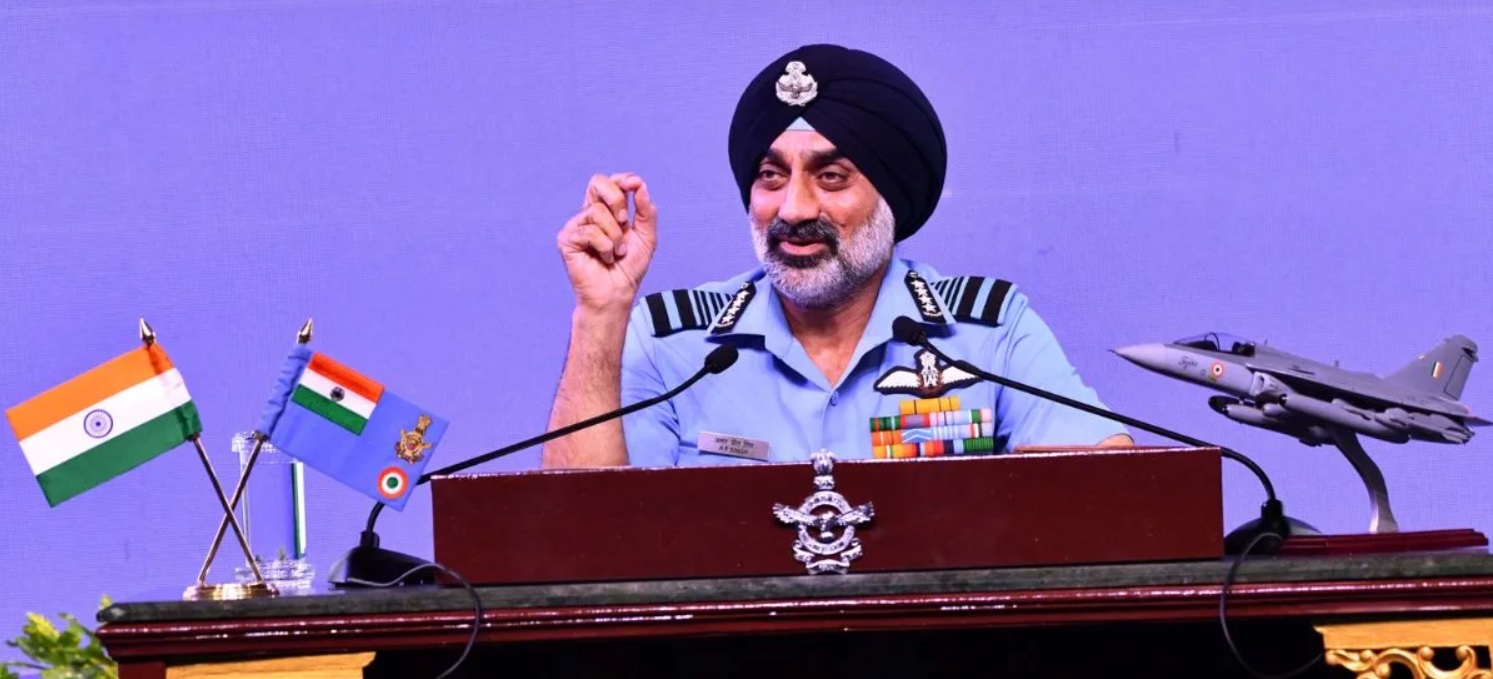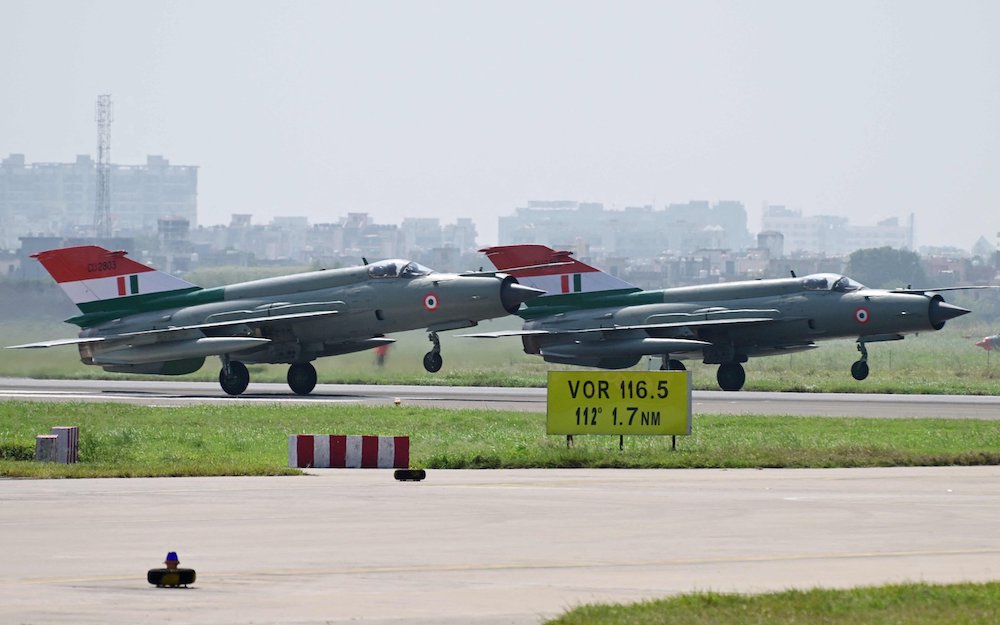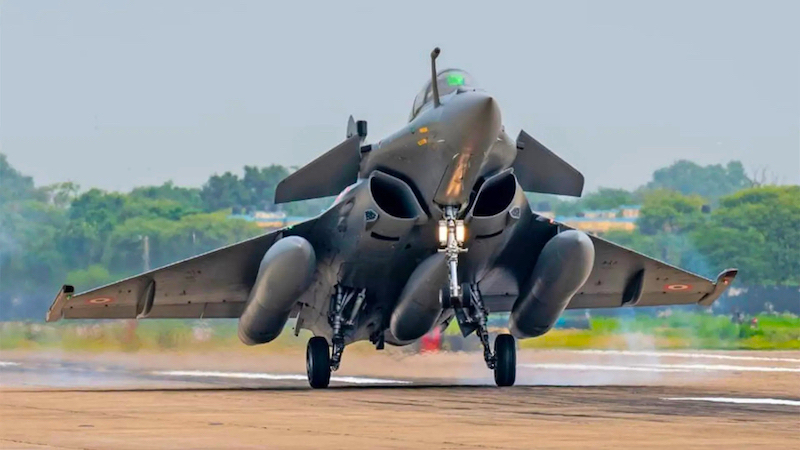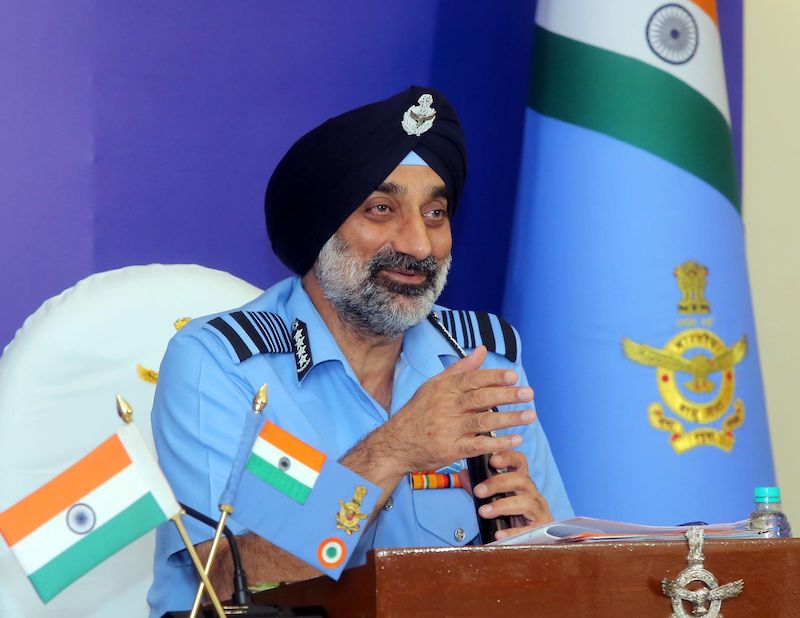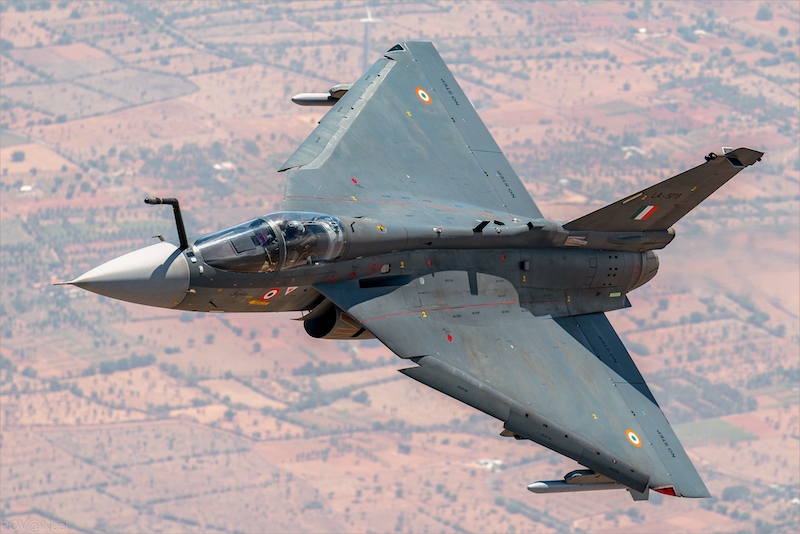 An IAF Tejas. (File photo for representation.)
An IAF Tejas. (File photo for representation.)
New Delhi: An Indian Air Force Tejas light combat aircraft plunged into the ground during an aerobatic display at the Dubai Air Show 2025 on Friday, killing the pilot in front of thousands of spectators at Al Maktoum International Airport. The crash occurred at approximately 2.10pm local time on the exhibition’s final day.
This is only the second known accident involving India’s indigenously developed fighter jet since the programme began test flights in 2001.
The single-engine, lightweight multirole fighter – manufactured by state-owned Hindustan Aeronautics Limited – was executing a negative-G turn at low altitude when it suddenly lost control. Multiple videos captured the aircraft nosediving sharply after attempting to recover from a loop manoeuvre, striking the ground and erupting in flames. Thick black smoke billowed across the airfield as emergency sirens sounded and horrified spectators, including families with children, watched the tragedy unfold.
An Indian Air Force #Tejas LCA crashed during an aerial demonstration at the Dubai Air Show 2025, going on at the UAE’s Al Maktoum International Airport. The pilot, who couldn’t eject, was killed in the accident.
— India Sentinels (@indiasentinels) November 21, 2025
More details awaited.@IAF_MCC @SpokespersonMoD @HQ_IDS_India pic.twitter.com/KOzg2U7dUn
The Indian Air Force confirmed the fatality in a social media statement: “An IAF Tejas aircraft met with an accident during an aerial display at Dubai Air Show, today. The pilot sustained fatal injuries in the accident. IAF deeply regrets the loss of life and stands firmly with the bereaved family in this time of grief.” No ejection was visible in footage of the incident, suggesting the pilot remained in the cockpit at impact. The IAF has ordered a court of inquiry to investigate the cause.
An IAF Tejas aircraft met with an accident during an aerial display at Dubai Air Show, today. The pilot sustained fatal injuries in the accident.
— Indian Air Force (@IAF_MCC) November 21, 2025
IAF deeply regrets the loss of life and stands firmly with the bereaved family in this time of grief.
A court of inquiry is being…
Circumstances of the crash
The crashed aircraft was an HAL Tejas Mk1 variant powered by a General Electric F404-IN20 turbofan engine, capable of producing 85 kilonewtons of thrust with afterburner. According to multiple reports, the jet belonged to a squadron based at Sulur Air Force Station in Tamil Nadu and had been in operational service since 2016. The IAF operates two Tejas Mk1 squadrons – No. 45 Squadron “Flying Daggers” and No. 18 Squadron “Flying Bullets,” both stationed at Sulur – though authorities have not officially confirmed which unit the aircraft belonged to.
Aviation experts who reviewed crash footage noted that the Tejas was executing a negative-G turn – a manoeuvre where the aircraft experiences forces opposite to gravity – just moments before impact. The jet appeared to lose altitude rapidly while attempting to recover from a loop performed at insufficient height. Sources told media outlets that the pilot was unable to regain control during this critical phase, with the aircraft descending almost vertically before striking the ground.
The negative-G manoeuvre is a complex aerobatic technique typically performed at higher altitudes to allow adequate recovery time. Initial assessments suggest that the combination of low altitude, high gravitational forces and the speed of the situation may have left the pilot with insufficient time or spatial awareness to execute a successful recovery. Investigators will examine flight data recorders, engine performance logs and human factors to determine whether technical malfunction, pilot error or environmental conditions contributed to the tragedy.
Dubai’s Government Media Office confirmed that firefighting and emergency teams responded rapidly to the crash site, managing the situation within approximately 45 minutes. The air show resumed flight demonstrations within 90 minutes, with other aircraft performing overhead as emergency crews continued their operations.
The defence minister, Rajnath Singh, issued a statement expressing his condolences: “Deeply anguished at the loss of a brave and courageous IAF pilot during an aerial display at the Dubai Air Show.” The chief of defence staff, General Anil Chauhan, and all ranks of the Indian armed forces also expressed regret over the incident. As of Friday evening, Air Force authorities had not released the name or rank of the deceased pilot, citing operational security and respect for the bereaved family.
Tejas LCA and its history
The Tejas Mk1 represents India’s first indigenously developed fighter aircraft, designed by the Aeronautical Development Agency and manufactured by HAL. It is a 4.5-generation, delta-wing, single-seat aircraft with a maximum take-off weight of 13,500 kilograms and a top speed of approximately Mach 1.6 to Mach 1.8. Despite using a foreign-supplied engine, the Tejas embodies India’s push toward self-reliance in defence manufacturing and is intended to replace the service’s ageing fleet of Russian-origin MiG-21 fighters.
Friday’s fatal accident is only the second crash involving the Tejas since its maiden test flight nearly 24 years ago – a safety record that had been a point of pride for the programme. The first incident occurred on March 12, 2024, near Jaisalmer in Rajasthan, during a triservices military exercise Bharat Shakti. In that crash, a Tejas Mk1 fighter went down shortly after participating in a live-fire demonstration at the Pokhran firing range. Unlike the Dubai tragedy, the pilot in the Rajasthan incident managed to eject safely before the aircraft hit the ground near a residential hostel complex.
An investigation into the March 2024 crash pointed to engine seizure as the most likely cause, triggered by an oil pump malfunction in the aircraft’s GE F404 engine. One official involved in the probe stated at the time: “The engine seizure appears to have been caused by an oil pump malfunction.”
Following that incident, the IAF ordered a fleet-wide inspection of all Tejas Mk1 aircraft to check for similar issues. The comprehensive safety checks found no systemic problems with the fighter fleet, and the aircraft were cleared to continue operations.
The contrasting nature of the two accidents – a technical engine failure in 2024 versus a possible manoeuvre-related loss of control in 2025 – highlights different risk factors in modern fighter operations. While the Rajasthan crash occurred during a routine training sortie and allowed for successful ejection, the Dubai incident unfolded during a high-pressure international aerobatic display at extremely low altitude, leaving no margin for error or escape.
Implications for Tejas programme
The tragedy at Dubai Air Show 2025 comes at a sensitive time for India’s indigenous defence programmes. Just one day before the crash, the Press Information Bureau had dismissed social media claims alleging oil leakage from a Tejas aircraft at the same event, calling circulating videos “fake” and “baseless propaganda” designed to undermine the fighter’s technical reliability.
The timing of the accident immediately following this official denial has intensified scrutiny of the aircraft’s performance and safety record.
India has ambitious plans for the Tejas programme. As India Sentinels had reported earlier, in September, the defence ministry signed a contract for 97 additional Mk1A variant aircraft – an upgraded version featuring enhanced avionics, active electronically scanned array radar and improved electronic warfare systems – at a cost exceeding ₹62,370 crore excluding taxes. Deliveries of the Mk1A are scheduled to begin in 2027–28. The IAF currently operates approximately 35 to 40 Tejas Mk1 jets across its two operational squadrons, with plans to expand the fleet significantly as older MiG-21 and MiG-27 fighters are phased out.
The crash has cast a shadow over India’s efforts to showcase its indigenous aerospace capabilities on the global stage and to position the Tejas as a viable export option for allied nations. Air shows like Dubai serve as critical marketing platforms where defence manufacturers demonstrate their products to potential customers. The highly visible nature of Friday’s accident – broadcast across social media and witnessed by international delegations – represents a significant setback for these ambitions.
Both crashes have prompted questions about display flight safety protocols, pilot training for high-stress performance environments and the operational limits of the Tejas platform during aggressive manoeuvring. The outcomes of the ongoing court of inquiry investigations are expected to influence future procedures for demonstration flights and may lead to revisions in operational safety guidelines for the IAF’s expanding Tejas fleet.
As investigators work to determine the precise cause of Friday’s fatal accident, the findings will have significant implications not only for operational safety procedures but also for the credibility and future trajectory of one of India’s most important defence manufacturing programmes. The loss of a trained fighter pilot – representing years of investment in training and experience – adds a human dimension to the technical questions that now surround the incident.




